

Research. Basrelief sculpture "Research holding the torch of knowledge" (1896) by Olin Levi Warner.
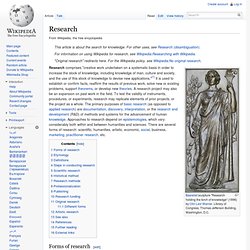
'Pataphysics. Jarry in Alfortville 'Pataphysics (French: 'pataphysique) is a philosophy or media theory dedicated to studying what lies beyond the realm of metaphysics.

The concept was coined by French writer Alfred Jarry (1873–1907), who defined 'pataphysics as "the science of imaginary solutions, which symbolically attributes the properties of objects, described by their virtuality, to their lineaments".[1] A practitioner of 'pataphysics is a pataphysician or a pataphysicist. Definitions[edit] There are over one hundred differing definitions of pataphysics.[2] Some examples are shown below. "Pataphysics is the science of that which is superinduced upon metaphysics, whether within or beyond the latter’s limitations, extending as far beyond metaphysics as the latter extends beyond physics. … Pataphysics will be, above all, the science of the particular, despite the common opinion that the only science is that of the general. "Pataphysics passes easily from one state of apparent definition to another. Annals of Improbable Research.
The Annals of Improbable Research (AIR) is a bi-monthly magazine devoted to scientific humor, in the form of a satirical take on the standard academic journal.
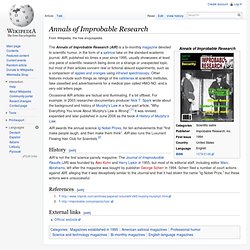
AIR, published six times a year since 1995, usually showcases at least one piece of scientific research being done on a strange or unexpected topic, but most of their articles concern real or fictional absurd experiments, such as a comparison of apples and oranges using infrared spectroscopy. Other features include such things as ratings of the cafeterias at scientific institutes, fake classified and advertisements for a medical plan called HMO-NO, and a very odd letters page. Occasional AIR articles are factual and illuminating, if a bit offbeat. For example, in 2003 researcher-documentary producer Nick T. AIR awards the annual science Ig Nobel Prizes, for ten achievements that "first make people laugh, and then make them think". Ig Nobel Prize. The Ig Nobel Prizes are a parody of the Nobel Prizes and are given each year in early October for ten unusual or trivial achievements in scientific research.

The stated aim of the prizes is to "honor achievements that first make people laugh, and then make them think. " The awards are sometimes veiled criticism (or gentle satire), but are also used to point out that even the most absurd-sounding avenues of research can yield useful knowledge. New media art. Newskool ASCII Screenshot.
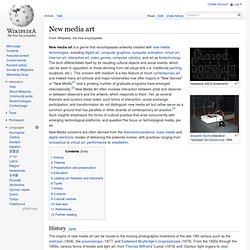
Workshop. This museum workshop containing tools and supplies has been in use for decades.

A small workshop with instruments. Application software. Application software is all the computer software that causes a computer to perform useful tasks beyond the running of the computer itself.
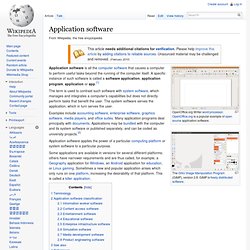
A specific instance of such software is called a software application, application program, application or app.[1] The term is used to contrast such software with system software, which manages and integrates a computer's capabilities but does not directly perform tasks that benefit the user. The system software serves the application, which in turn serves the user. Application software applies the power of a particular computing platform or system software to a particular purpose. Unity (game engine) Unity is a cross-platform[2] game engine with a built-in IDE developed by Unity Technologies.
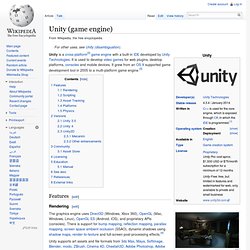
It is used to develop video games for web plugins, desktop platforms, consoles and mobile devices. It grew from an OS X supported game development tool in 2005 to a multi-platform game engine.[3] Gone Home is a 2013 video game built with the Unity engine. Scratch (programming language) Scratch is a free desktop and online multimedia authoring tool that can be used by students, scholars, teachers, and parents to easily create games and provide a stepping stone to the more advanced world of computer programming or even be used for a range of educational and entertainment constructivist purposes from math and science projects, including simulations and visualizations of experiments, recording lectures with animated presentations, to social sciences animated stories, and interactive art and music.

Viewing the existing projects available on the Scratch website, or modifying and testing any modification without saving it requires no online registration. Scratch 2 is currently available online and as an application for Windows, Mac OS X and Linux.[1][2] The source code of Scratch 1.x is made available under GPLv2 license and Scratch Source Code License.[3] The Scratch programming language is also used in the game creation tool Stencyl. The first web-based Scratch in 2006. Game Maker. Gamemaker or Game Maker may refer to:
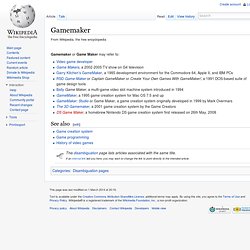
Archive. Shelved record boxes of an archive. Documentation. Documentation is a set of documents provided on paper, or online, or on digital or analog media, such as audio tape or CDs. Example are user guides, white papers, on-line help, quick-reference guides. It is becoming less common to see paper (hard-copy) documentation. Documentation is distributed via websites, software products, and other on-line applications. Professionals educated in this field are termed documentalists. This field changed its name to information science in 1968, but some uses of the term documentation still exists and there have been efforts to reintroduce the term documentation as a field of study. Principles for producing documentation[edit] Sophie Calle. Sophie Calle (born 1953) is a French writer, photographer, installation artist, and conceptual artist.[1] Calle's work is distinguished by its use of arbitrary sets of constraints, and evokes the French literary movement of the 1960s known as Oulipo.
Her work frequently depicts human vulnerability, and examines identity and intimacy. She is recognized for her detective-like ability to follow strangers and investigate their private lives. Her photographic work often includes panels of text of her own writing. Since 2005 Sophie Calle has taught as a professor of film and photography at European Graduate School in Saas-Fee, Switzerland.[1] She has lectured at the University of California, San Diego in the Visual Arts Department.[2] She has also taught at Mills College in Oakland, California. Exhibitions featuring the work of Sophie Calle took place at the Hermitage Museum in St. Early works[edit] After completing her schooling she travelled for seven years. Later works[edit] Expanded Cinema. Expanded Cinema by Gene Youngblood (1970), the first book to consider video as an art form, was influential in establishing the field of media arts.[1] In the book he argues that a new, expanded cinema is required for a new consciousness.
He describes various types of filmmaking utilising new technology, including film special effects, computer art, video art, multi-media environments and holography. Part One: The Audience and the Myth of Entertainment[edit] In the first part of the book, Youngblood attempts to show how expanded cinema will unite art and life. Experimental film. Brothers Quay. Stephen and Timothy Quay (/ˈkweɪ/ KWAY; born June 17, 1947) are American identical twin brothers better known as the Brothers Quay or Quay Brothers. They are influential stop-motion animators. They are also the recipients of the 1998 Drama Desk Award for Outstanding Set Design for their work on the play The Chairs. Careers[edit] Most of their animation films feature puppets made of doll parts and other organic and inorganic materials, often partially disassembled, in a dark, moody atmosphere. Perhaps their best known work is Street of Crocodiles, based on the short novel of the same name by the Polish author and artist Bruno Schulz.
Before turning to film, the Quays worked as professional illustrators. In an interview with Robert K. Video art. Bill Viola. Video game. A video game is an electronic game that involves human interaction with a user interface to generate visual feedback on a video device. The word video in video game traditionally referred to a raster display device,[1] but it now implies any type of display device that can produce two- or three-dimensional images. The electronic systems used to play video games are known as platforms; examples of these are personal computers and video game consoles. These platforms range from large mainframe computers to small handheld devices. Art game. Tracy Fullerton. Fullerton appeared in Danny Ledonne's documentary Playing Columbine. Tale of Tales (developer) TALE OF TALES. Molleindustria. Molleindustria is an Italian guerrilla semiotics and culture jamming website[1] that produces flash videogames based on provocative left-wing socio-political points of view, like on topics like labour market flexibility and Queer theory, in explicit opposition with the mainstream video game industry.[2] They feature games like Queer Power, Faith Fighter and the McDonald's Videogame.
In June 2007 the game Operazione: Pretofilia (Operation: Pedopriest), inspired by the controversial BBC documentary Sex Crimes and the Vatican, was removed from the site after a point of order in the Italian Parliament called "Countermeasures to the religions' offences".[3] In April 2009, Molleindustria initially bowed to complaints from the Organisation of the Islamic Conference by removing Faith Fighter from their site,[4] but later put up a new version that gives the player the choice between a full and a censored version.
Interactive storytelling. Temporality. Loop. Loop or LOOP may refer to: Narrativity. Narrativity is a common subject of debate in film theory. Database.